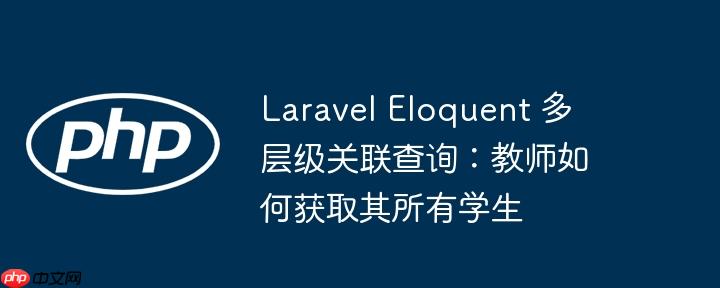
1. 理解数据库结构与业务场景
在构建复杂的关联查询之前,首先需要清晰地理解数据库表结构及其代表的业务逻辑。本教程将围绕以下三张核心表及其关联表展开:
- teachers 表: 存储教师信息,包含 id, username, pass 等字段。
- periods 表: 存储课程周期信息,包含 id, teacher_id, name 等字段。teacher_id 字段表明一个课程周期属于一个特定的教师。
- students 表: 存储学生信息,包含 id, username, pass 等字段。
- student_period 表: 作为 students 和 periods 表之间的中间表,实现多对多关系,包含 student_id, period_id 字段。
我们的目标是:给定一个教师,查询该教师通过其教授的课程周期所关联的所有学生。这涉及到从 Teacher -youjiankuohaophpcn Period -> Student 的多层级路径。
2. 定义 Eloquent 模型关系
为了让 Eloquent ORM 能够理解这些表之间的联系,我们需要在相应的模型中定义好关系。
2.1 Teacher 模型
一个教师可以有多个课程周期。
// app/Models/Teacher.php
namespace App\Models;
use Illuminate\Database\Eloquent\Model;
use Illuminate\Database\Eloquent\Relations\HasMany;
class Teacher extends Model
{
// 定义教师拥有的课程周期
public function periods(): HasMany
{
return $this->hasMany(Period::class);
}
}2.2 Period 模型
一个课程周期属于一个教师,并且可以包含多个学生。
// app/Models/Period.php
namespace App\Models;
use Illuminate\Database\Eloquent\Model;
use Illuminate\Database\Eloquent\Relations\BelongsTo;
use Illuminate\Database\Eloquent\Relations\BelongsToMany;
class Period extends Model
{
// 定义课程周期所属的教师
public function teacher(): BelongsTo
{
return $this->belongsTo(Teacher::class);
}
// 定义课程周期包含的学生(多对多关系)
public function students(): BelongsToMany
{
return $this->belongsToMany(Student::class);
}
}2.3 Student 模型
一个学生可以参与多个课程周期。
// app/Models/Student.php
namespace App\Models;
use Illuminate\Database\Eloquent\Model;
use Illuminate\Database\Eloquent\Relations\BelongsToMany;
class Student extends Model
{
// 定义学生参与的课程周期(多对多关系)
public function periods(): BelongsToMany
{
return $this->belongsToMany(Period::class);
}
}3. 执行多层级关联查询
定义好模型关系后,我们就可以利用 Eloquent 提供的 whereHas 方法来执行复杂的嵌套查询。
3.1 查询特定教师的所有学生
要获取某个特定教师的所有学生,我们可以从 Student 模型开始查询,然后通过 periods 关系和 teacher 关系进行筛选。
use App\Models\Student;
use App\Models\Teacher; // 如果需要通过Teacher模型实例获取ID
// 假设我们想获取 ID 为 1 的教师的所有学生
$teacherId = 1;
$students = Student::whereHas('periods', function ($periodQuery) use ($teacherId) {
// 在 periods 关系中,进一步筛选属于特定教师的 period
$periodQuery->whereHas('teacher', function ($teacherQuery) use ($teacherId) {
$teacherQuery->where('id', $teacherId);
});
})->get();
// 遍历并输出学生信息
foreach ($students as $student) {
echo "学生 ID: " . $student->id . ", 用户名: " . $student->username . "\n";
}代码解析:
- Student::whereHas('periods', ...): 这行代码表示我们希望获取那些至少关联了一个课程周期(periods)的学生。whereHas 的第二个参数是一个闭包,用于进一步约束 periods 关系。
- $periodQuery->whereHas('teacher', ...): 在第一个 whereHas 的闭包内部,我们再次使用了 whereHas。这次是在 period 模型上查找那些关联了特定教师(teacher)的课程周期。
- $teacherQuery->where('id', $teacherId): 这是最内层的条件,它筛选出 teacher 表中 id 等于 $teacherId 的记录。
通过这种嵌套的 whereHas 结构,Eloquent 能够有效地构建出 SQL JOIN 语句,从而实现从 Student -> Period -> Teacher 的反向筛选。
4. 注意事项与优化
-
N+1 问题: 上述查询本身不会导致 N+1 问题,因为它在数据库层面通过 JOIN 完成筛选。但是,如果你在获取学生后,又循环访问每个学生的 periods 或每个 period 的 teacher,那么可能会出现 N+1 问题。
-
解决方案: 使用 with 进行预加载。例如,如果你还需要每个学生关联的课程周期信息:
$students = Student::with('periods') // 预加载学生的 periods ->whereHas('periods.teacher', function ($teacherQuery) use ($teacherId) { $teacherQuery->where('id', $teacherId); })->get(); - 如果你还需要每个课程周期所属的教师信息:
$students = Student::with('periods.teacher') // 预加载学生的 periods,以及每个 period 的 teacher ->whereHas('periods.teacher', function ($teacherQuery) use ($teacherId) { $teacherQuery->where('id', $teacherId); })->get();
-
解决方案: 使用 with 进行预加载。例如,如果你还需要每个学生关联的课程周期信息:
- 反向关联: 在某些情况下,你可能希望从 Teacher 模型直接访问其所有学生。这可以通过 hasManyThrough 或自定义中间方法实现,但对于本例,从 Student 模型开始查询通常更直接和高效,因为它直接筛选了最终目标。
- 性能考量: 对于大型数据集,确保 teacher_id 在 periods 表上以及 student_id 和 period_id 在 student_period 表上都有索引,以优化查询性能。
5. 总结
Laravel Eloquent 强大的关系定义和查询方法使得处理多层级关联变得简单而直观。通过正确定义 hasMany 和 belongsToMany 关系,并利用 whereHas 方法,开发者可以高效地构建复杂的查询,从而满足各种业务需求,如本教程中获取特定教师的所有学生。理解这些机制不仅能提升开发效率,还能帮助构建更健壮、性能更优的应用程序。
以上就是Laravel Eloquent 多层级关联查询:教师如何获取其所有学生的详细内容,更多请关注资源网其它相关文章!







发表评论:
◎欢迎参与讨论,请在这里发表您的看法、交流您的观点。